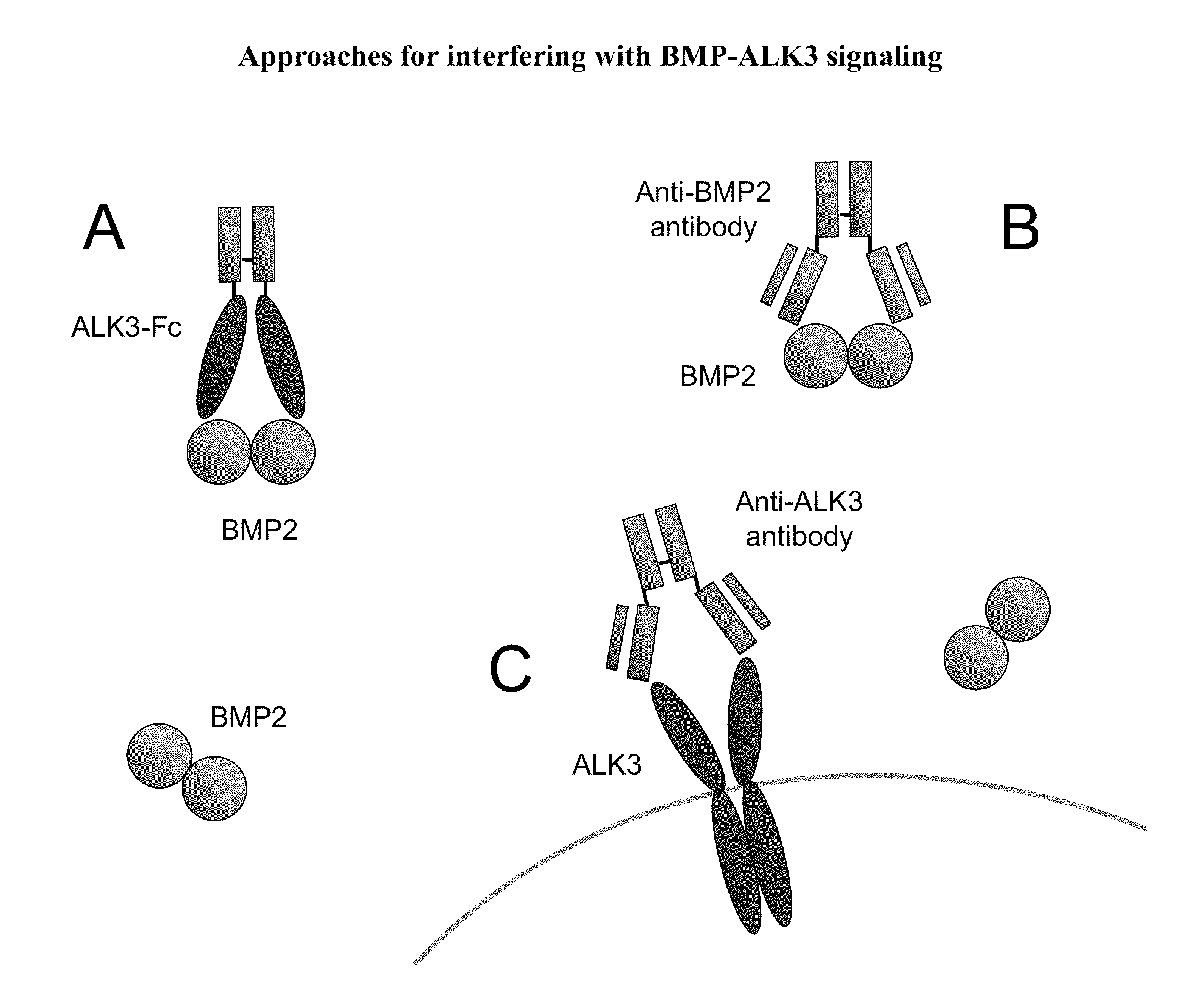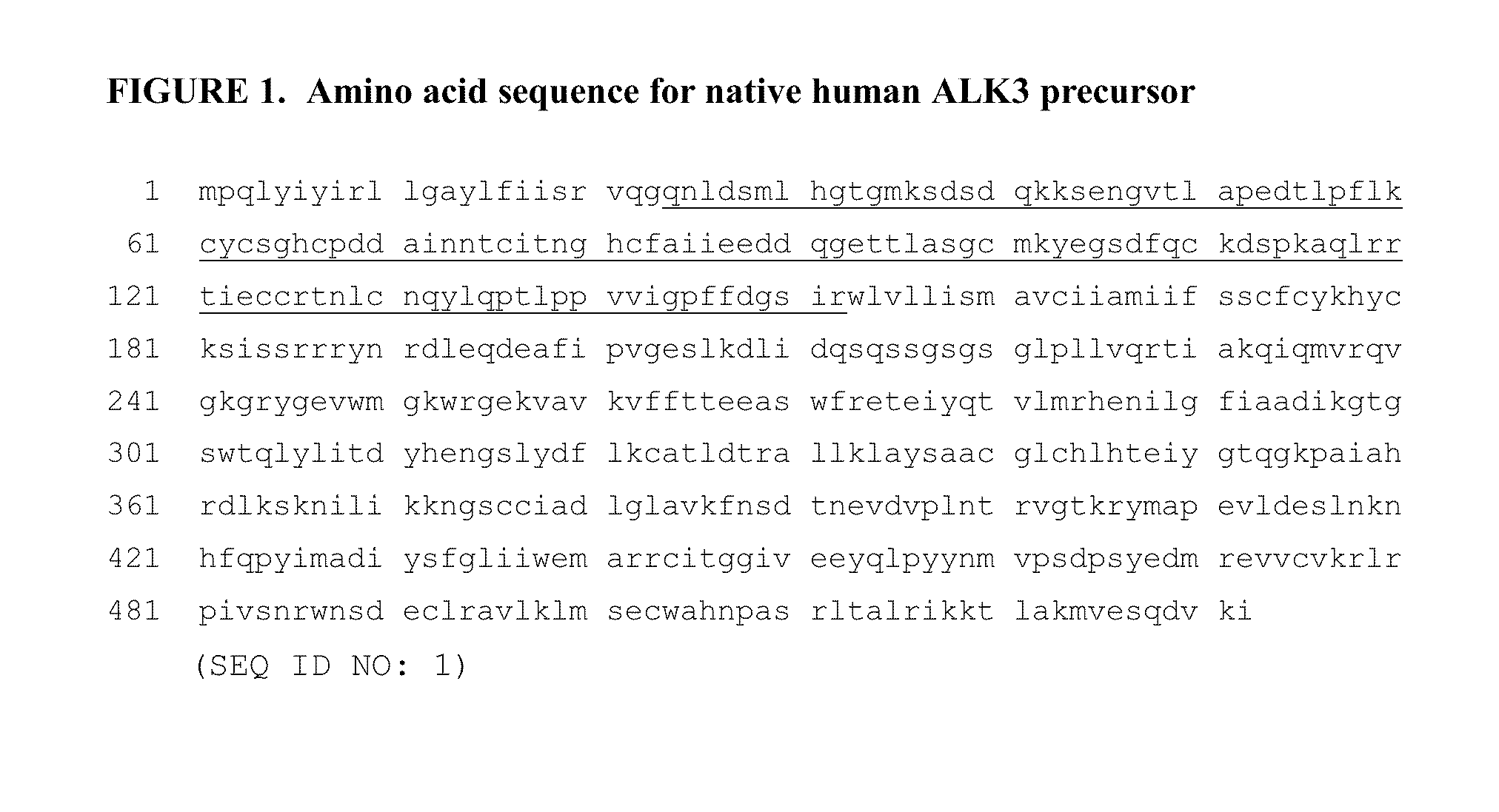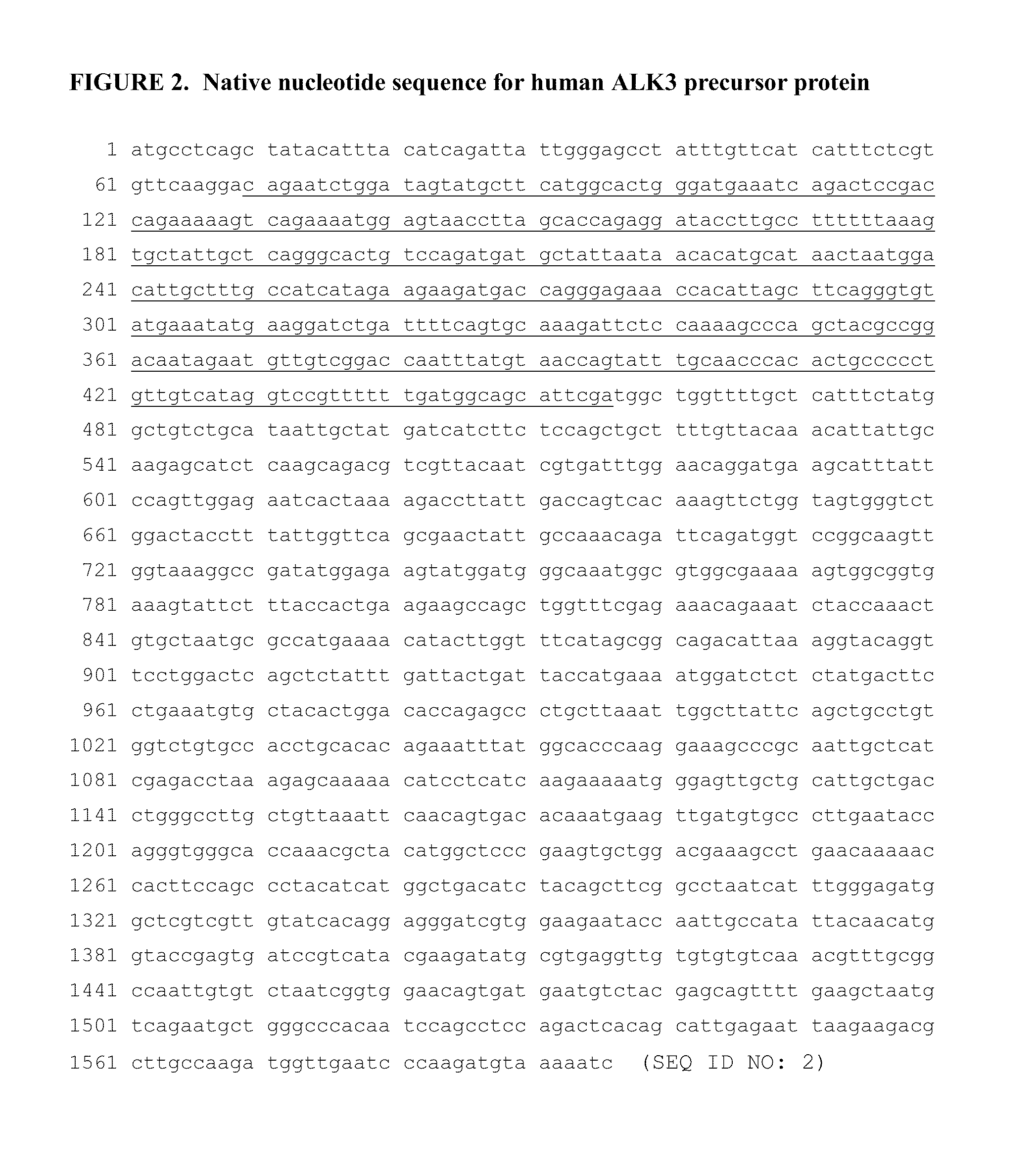Bmp-alk3 antagonists and uses for promoting bone growth
a technology of alk3 and bmp, which is applied in the direction of peptide/protein ingredients, dna/rna fragmentation, fusion polypeptide, etc., can solve the problems of significant medical problems, imbalances in the normal bone remodeling process, and often associated side effects of therapeutics, so as to stimulate the growth or increase the mineralization of bon
- Summary
- Abstract
- Description
- Claims
- Application Information
AI Technical Summary
Benefits of technology
Problems solved by technology
Method used
Image
Examples
example 1
EXAMPLE 1
Generation of ALK3-Fc Fusion Proteins
[0155]The amino acid sequence and corresponding nucleotide sequence for native human ALK3 are shown in FIGS. 1, 2. Applicants designed an ALK3-hFc fusion protein in which the extracellular domain (native residues 24-152) of human ALK3 (FIGS. 3, 4) is fused C-terminally with a human Fc domain (FIGS. 5, 6) via a minimal linker (comprised of amino acid residues TGGG) to yield the protein shown in FIG. 7. The following three leader sequences were considered:
(i) Native:MPQLYIYIRLLGAYLFIISRVQG(SEQ ID NO: 8)(ii) Tissue plasminogen activator (TPA):MDAMKRGLCCVLLLCGAVFVSP(SEQ ID NO: 9)(iii) Honey bee melittin (HBML):MKFLVNVALVFMVVYISYIYA(SEQ ID NO: 10)
The selected form of hALK3(24-152)-hFc (SEQ ID NO: 11) employs the TPA leader and has the unprocessed amino-acid sequence shown in FIG. 8. A sense nucleotide sequence encoding this fusion protein and the corresponding antisense sequence are indicated in FIG. 9. Shown below is an alternative sense nu...
example 2
Ligand Binding to ALK3-Fc
[0157]Biacore™ methodology was used to determine the binding affinity of ALK3-Fc fusion proteins for more than 15 members of the BMP / GDF family. mALK3-mFc derived from HEK 293 cells displayed high-affinity binding to hBMP2 and hBMP4 (KD=2.43×10−9 and 9.47×10−10, respectively), as well as moderate-affinity binding to several other ligands, including hBMP6 and hBMP7. hALK3(24-152)-hFc displayed a similar binding profile. Specifically, hALK3(24-152)-hFc derived from HEK 293 cells bound to hBMP2 and hBMP4 with KDs of 6.53×10−10 and 1.02×10−9, respectively, while hALK3(24-152)-hFc derived from CHO cells bound to hBMP2 and hBMP4 with KDs of 4.53×10−10 and 7.03×10−10, respectively. Like mALK3(24-152)-mFc, hALK3(24-152)-hFc derived from both cell types exhibited moderate affinity binding to hBMP6 and hBMP7, among other ligands.
[0158]The overall selectivity of ALK3-Fc for BMP2 and BMP4 is notable. While not wishing to be bound to any particular mechanism, Applicants ...
example 3
EXAMPLE 3
hALK3-mFc Improves Bone Status in Mice
[0162]Applicants investigated the ability of a version of ALK3-mFc to improve bone status in mice. Twelve-week-old female C57BL / 6 mice (n=8 per group) were treated with hALK3(24-152)-mFc, 10 mg / kg, or vehicle (Tris-buffered saline) by intraperitoneal injection twice per week for a total of six weeks. Compared to vehicle, hALK3(24-152)-mFc significantly increased whole-body bone density, as determined by dual energy x-ray absorptiometry (DEXA), by Day 31 and maintained this effect through study completion on Day 42 (FIG. 12). A similar effect of hALK3(24-152)-mFc treatment on bone density was observed for localized analysis of lumbar vertebrae by DEXA at these same time points (FIG. 13). In addition, high-resolution measurements of the tibial shaft and proximal tibia were conducted by micro-computed tomography (micro-CT) to determine the effect of hALK3(24-152)-mFc on cortical bone and trabecular bone, respectively. As compared to vehic...
PUM
| Property | Measurement | Unit |
|---|---|---|
| dissociation constant | aaaaa | aaaaa |
| dissociation constant | aaaaa | aaaaa |
| temperature | aaaaa | aaaaa |
Abstract
Description
Claims
Application Information
 Login to View More
Login to View More - R&D
- Intellectual Property
- Life Sciences
- Materials
- Tech Scout
- Unparalleled Data Quality
- Higher Quality Content
- 60% Fewer Hallucinations
Browse by: Latest US Patents, China's latest patents, Technical Efficacy Thesaurus, Application Domain, Technology Topic, Popular Technical Reports.
© 2025 PatSnap. All rights reserved.Legal|Privacy policy|Modern Slavery Act Transparency Statement|Sitemap|About US| Contact US: help@patsnap.com



